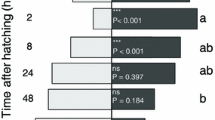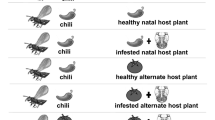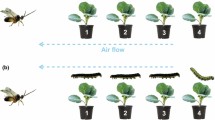Abstract
Plant-herbivore chemical signals and behavioral plasticity may enhance parasitoid host-foraging efficacy in the field; however, no studies have quantified the potential benefits from these factors under field-type conditions. The effect of plant-herbivore signals and learning on the foraging efficacy of Microplitis croceipes was quantified by directly observing and recording total and sequential duration of various foraging behaviors relative to 5 randomly placed herbivore-damaged and host-infested cotton plants and 20 undamaged and non-host-infested plants. Microplitis croceipes spent significantly more time searching (flying and antennation) on host infested versus uninfested plants. Antennation time was significantly and negatively correlated with successive host stings. Contrary to expectations of increased duration, flight time remained constant throughout the foraging bout, which may indicate that there was some learning associated with flight. These results suggest that plant-herbivore chemical signals and learning enhances the foraging efficacy of M. croceipes.
Similar content being viewed by others

References
Agrawal, A. A., Tuzun, S., and Bent, E. (1999). Induced Plant Defenses Against Pathogens and Herbivores: Biochemistry, Ecology, and Agriculture, APS Press, St. Paul, MN.
Burton, R. L. (1970). A low-cost artificial diet for the corn earworm. J. Econ. Entomol. 63: 1969-1970.
Clouter, C. (1984). The effect of host density on egg distribution by the solitary parasitoid, Aphidius nigripes (Hymenoptera: Aphelinidae). Can. Entomol. 116: 805-811.
De Moraes, C. M., Lewis, W. J., Pare, P. W., Alborn, H. T., and Tumlinson, J. H. (1998). Herbivore-infested plants selectively attract parasitoids. Nature 393: 570-573.
De Moraes, C. M., Cortesero, A. M., Stapel, J. O., and Lewis, W. J. (1999). Intrinsic and extrinsic competitive interactions between two larval parasitoids of Heliothis virescens. Ecol. Entomol. 24: 402-410.
Doutt, R. L. (1964). Biological characteristics of entomophagous adults. In DeBach, P. (ed.), Biological Control of Pests and Weeds, Reinhold, New York, pp. 145-167.
Drost, Y. C., Lewis, W. J., Zanen, P. O., and Keller, M. A. (1986). Beneficial arthropod behavior mediated by airborne semiochemicals. I. Flight behavior and influence of pre-flight handling of Microplitis croceipes (Cresson). J. Chem. Ecol. 12: 1247-1262.
Eller, F. (1990). Foraging behavior of Microplitis croceipes, a parasitoid of Heliothis species. Ph.D. thesis, University of Florida, Gainesville.
Gross, P. (1993). Insect behavioral and morphological defenses against parasitoids. Annu. Rev. Entomol. 38: 251-273.
Ikawa, T., and Suzuki, Y. (1982). Ovipositional experience of the gregarious parasitoid, Apanteles glomeratus (Hymenoptera: Bracondidae), influencing her discrimination of the host, Pieris rapae crucivora. Appl. Entomol. Zool. 17: 119-126.
Jones, R. L., Lewis, W. J., Bowman, M. C., Beroza, M., and Bierl, B. A. (1971). Host-seeking stimulant for parasite of corn earworm: Isolation, identification and synthesis. Science 173: 842-843.
King, E. G., and Leppla, N. C. (1984). Advances and Challenges in Insect Rearing, Agricultural Research Service USDA, U.S. Government Printing Office, Washington, DC.
Lewis, W. J., and Burton, R. L. (1970). Rearing Microplitis in the laboratory with Heliothis zea as hosts. J. Econ. Entomol. 63: 656-658.
Lewis, W. J., and Snow, J. W. (1971). Fecundity sex ratio, and egg distribution by Microplitis croceipes, a parasite of Heliothis. J. Econ. Entomol. 64: 6-8.
Lewis, W. J., and Tumlinson, J. H. (1988). Host detection by chemically mediated associative learning in a parasitic wasp. Nature 331: 257-259.
Lewis, W. J., Stapel, J. O., Cortesero, A. M., and Takasu, K. (1998). Understanding how parasitoids balance food and host needs: Importance to biological control. Biol. Control 11: 175-183.
Mattiacci, L., Dicke, M., and Posthumus, M. A. (1994). Induction of parasitoid attracting synomone in brussels sprouts plants by feeding of Pieris brassicae larvae: Role of mechanical damage and herbivore elicitor. J. Chem. Ecol. 20: 2229-2247.
Meiners, T., Westerhaus, C., and Hilker, M. (2000). Specificity of chemical cues used by a specialist egg parasitoid during host location. Entomol. Exp. Appl. 95(2): 151-159.
Nufio, C. R., and Papaj, D. R. (2001). Host marking behavior in phytophagous insects and parasitoids. Entomol. Exp. Appl. 99: 273-293.
Price, P. W., Bouton, C. E., Gross, P., McPheron, B. A., Thompson, J. N., and Weis, A. E. (1980). Interactions among three trophic levels: Influence of plants on interactions between insect herbivores and natural enemies. Annu. Rev. Ecol. Syst. 11: 41-65.
SAS Institute Inc. (1997). SAS User's Guide: Statistics, Version 8 ed., SAS Institute Inc., Cary, NC.
Turlings, T. C., Tumlinson, J. H., and Lewis, W. J. (1990). Exploitation of herbivore-induced plant odors by host seeking parasitic wasps. Science 250: 1251-1253.
Turlings, T. C., Tumlinson, J. H., Eller, F. J., and Lewis, W. J. (1991). Larval-damaged plants: Source of volatile synomones that guide the parasitoid Cotesia marginiventris to the microhabitat of its host. Entomol. Exp. Appl. 58: 72-85.
van Alphen, J. J. M., and Nell, H. W. (1982). Superparasitism and host discrimination by Asobara tabida Nees (Bracondidae: Alysiinae), larval parasitoid of Drosophilidae. Neth. J. Zool. 32: 232-260.
van Lenteren, J. C. (1981). Host discrimination by parasitoids. In Nordlund, D. A., and Jones, R. L. (Eds.), Semiochemicals, Their Role in Pest Control, John Wiley, New York, pp. 153-180.
Vet, L. E. M., and Dicke, M. (1992). Ecology of infochemical use by natural enemies in a tritrophic context. Annu. Rev. Entomol. 38: 141-172.
Vet, L. E. M., Lewis, W. J., and Cardé, R. T. (1995). Parasitoid foraging and learning. In Cardé, R. T., and Bell, W. J. (Eds.), Chemical Ecology of Insects 2, Chapman & Hall, New York, pp. 65-101.
Vinson, S. B. (1981). Habitat location. In Jones, R. L., and Lewis, W. J. (Eds.), Semiochemicals, Their Role in Pest Control, John Wiley, New York, pp. 51-77.
Wäckers, F. L., and Lewis, W. J. (1994). Olfactory and visual learning and their combined influence on host site location by the parasitoid Microplitis croceipes (Cresson). Biol. Control 4: 105-112.
Wäckers, F. L. (1994). Host discrimination in flight and following alightment by the parasitoid Microplitis croceipes: A study of Sensory mechanisms. In Multisensory Foraging by Hymenopterous Parasitoids, Ph.D. thesis, University of Wageningen, Wageningen, The Netherlands.
Author information
Authors and Affiliations
Corresponding author
Rights and permissions
About this article
Cite this article
Olson, D.M., Hodges, T.A. & Lewis, W.J. Foraging Efficacy of a Larval Parasitoid in a Cotton Patch: Influence of Chemical Cues and Learning. Journal of Insect Behavior 16, 613–624 (2003). https://doi.org/10.1023/B:JOIR.0000007699.31659.14
Issue Date:
DOI: https://doi.org/10.1023/B:JOIR.0000007699.31659.14



